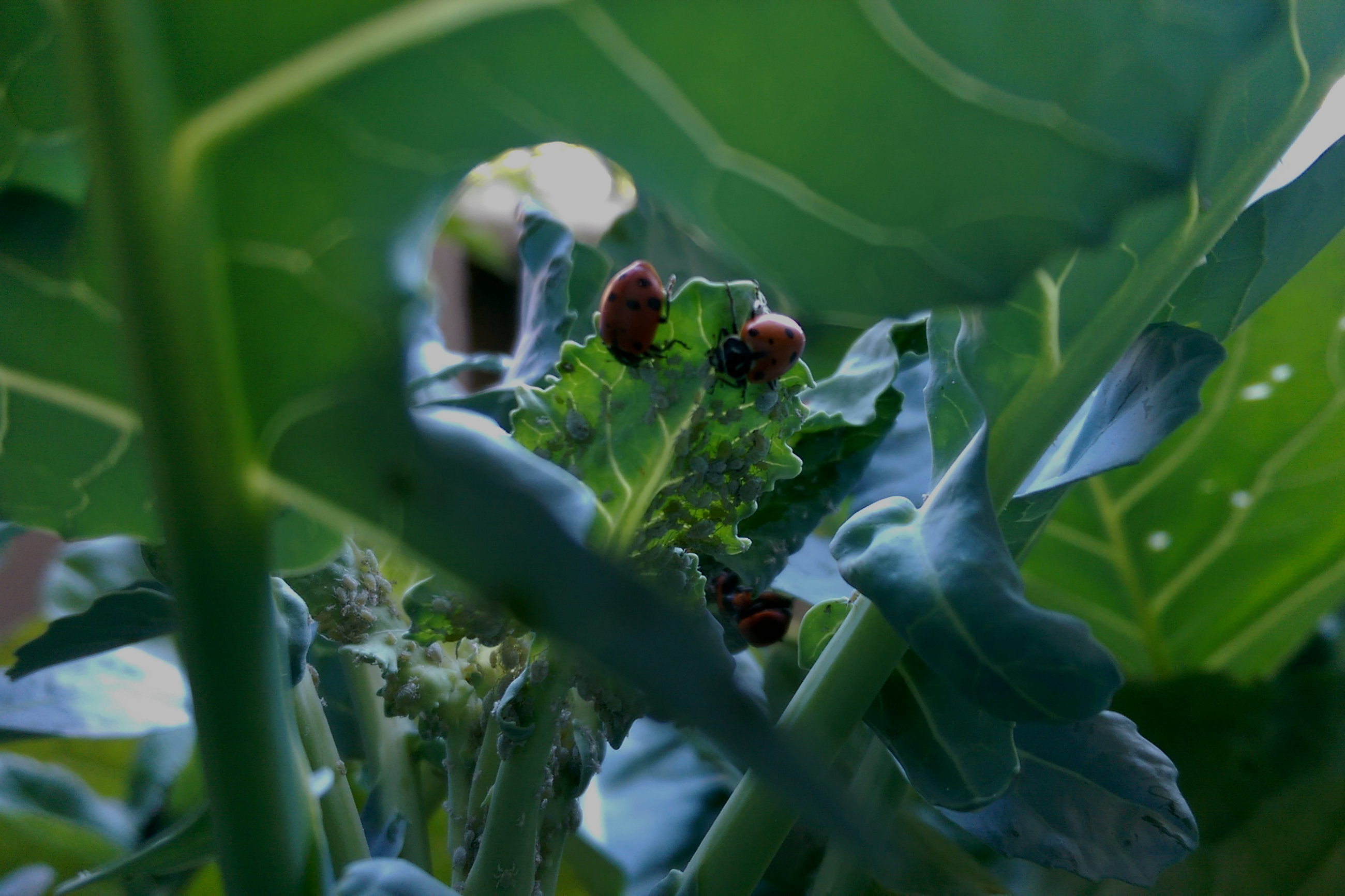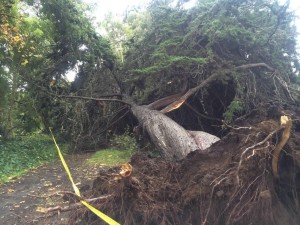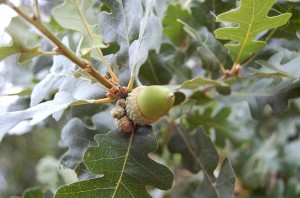abcnews http://abc7news.com/weather/many-across-bay-area-welcome-rainfall/418295/
Rain is finally coming down in the SF Bay Area, and we are all rejoicing. But what about trees, are they happy? How do tall, woody plants deal with rain and moisture in other forms? What happens when you add in variables like wind, soils, and other vegetation?
At this time of year rain replenishes the soil water bank, and trees and other plants begin making withdrawals. Too much rain over too short a period of time causes runoff and slow drainage in some areas, causing flooding, ponding, and in some cases tree failures from uprooting.
In San Francisco’s Golden Gate Park, and other areas with weakly structured soils, trees fall down. There simply isn’t enough strength in the soil-root connection to hold the tree up. An example is the Monterey cypress (Cupressus macrocarpa) tree (above) that fell on 12/2/14.
Every plant species has evolved in an environment that has a particular moisture regime that can be understood in terms of precipitation or water gained, versus transpiration or water lost by the species physiological processes. Plants that are from dry areas like deserts and arid ecosystems are adapted for low and very low water use. Others that developed in wet areas like tropical rain forests and other humid ecosystems require high and very high amounts of water to survive and reproduce. So one of the most important questions to ask about your trees is, where is this tree from; arid or humid areas of the planet?
Many trees are indigenous to the SF Bay Area, including five species of oaks. Each species of oaks has a different ecological niche where it thrives. Plant indigenous plants that are drought tolerant, but if you are planting them, you might need to water and protect them until they get established, which may take several years.
Blue oak (Quercus douglassii) is found in Contra Costa County (and elsewhere) on sandy soils, and areas with sandstone bedrock that is near the soil surface. It grows very slowly as it matures, and even small blue oaks may be very old, especially when growing in arid areas.
Water falls from the sky as rain, snow or fog; or rises from the earth as dew. Some plants, including coast redwood (Sequoia sempervirens) can even take up moisture through their foliage, but most plants absorb water through their roots that also anchor the tree. Plant roots take advantage of space, moisture and ease of growth. In rocky, shallow soils that have bedrock near the surface they may grow down through the cracks of rocks to a great depth, while in sandy poorly structured soils like sand dunes the may spread shallowly along the surface. Every site and micro site has a different root distribution. You need to dig holes and look, to find out where your tree’s roots are located.
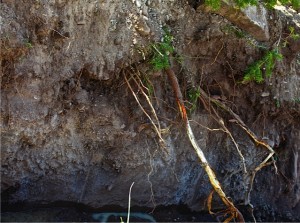 rocky Montana hillside, young fir tree roots concentrated in top 6”
rocky Montana hillside, young fir tree roots concentrated in top 6”
How many inches of rain must fall until the top twelve inches of the soil is full of water? In reality this depends on a large number of variables, but in controlled situations, without plants or canopies of plants, one inch of rain or irrigation water will reach as far as sixteen inches, while the same inch of water will only wet the top four or five inches of a clay textured soil. In the real world of forests and gardens, plants have canopies of various thicknesses, undulating topography, variable soil textures, compaction layers, mulch layers, etc., that all affect the amount of water needed to wet the soil and provide adequate water for the plants.
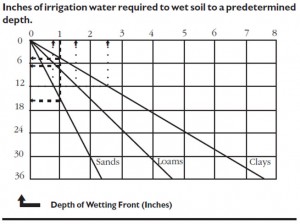 https://extension.umass.edu/turf/fact-sheets/turf-irrigation-and-water-conservation
https://extension.umass.edu/turf/fact-sheets/turf-irrigation-and-water-conservation
Wet soil that is walked, ridden or driven on becomes compacted and the soil’s ability to absorb water and sustain microbial life is diminished, causing reduced root growth and tree health decline. Soil compaction kills plants of all kinds by reducing oxygen and pore space in between soil particles, creating an environment favorable to plant disease causing organism that infect weakened roots.
 Valley oak (Q. lobata) surrounded by eroding, compacted soil caused by bike and motor vehicle traffic – the tree’s are stunted
Valley oak (Q. lobata) surrounded by eroding, compacted soil caused by bike and motor vehicle traffic – the tree’s are stunted
What can we do in this rainy season to help out our trees and the environment? Here are my top three suggestions;
1) enhance soil health near trees by maintaining decomposing organic matter (mulch) on soil surfaces, preferably from the plants themselves (mulch in place)
2) do not walk, ride, park or work within the driplines of trees or if the trees have been pruned back, within 15 feet of their trunks if the soil is wet
3) plant indigenous trees and other plants that are adapted to the microclimate of the site you plant them in
